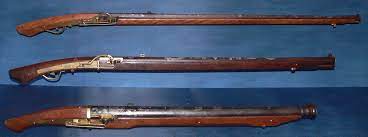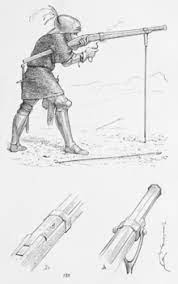Key Point: The Arquebus is an early firearm that was fired using the matchlock mechanism.
This article covers everything you need to know about the Arquebus. So, by the time you finish this article, you will know the origin of the Arquebus, why and how it was used, and why it was eventually replaced. If you are curious about the Arquebus then keep reading.
So what is an Arquebus, and how was the Arquebus used?
Here is the main takeaway from the article:
The arquebus was a large, muzzle-loading firearm that was fired from the shoulder. It had a longer barrel than earlier types of firearms, such as the hand cannon, and it was typically loaded with a single lead ball.
The arquebus was fired using a matchlock mechanism, which was a slow-burning cord, or match, that ignited the gunpowder in the barrel. This made the arquebus relatively easy to use with a range between 100 and 200 meters. Though it was much less accurate and reliable than later firearms.
What about the dimensions of an average arquebus? Well, while dimensions can and did vary across regions a general rule regarding the dimension of the Arquebus is:
Length: 4-5 feet (1.2 to 1.5 meters), Weight: 10-15 pounds (4.5-6.8kg) Here is how they looked:

Now, that we got the short summary of the article out of the way, it’s time we go deeper. Starting with the history and the origin of the Arquebus. Let’s go!
The Origin And History Of The Arquebus
The history of the arquebus can be traced back to the late 15th century when it was developed in Europe. Most likely in Spain or Italy. The arquebus was an improvement over earlier types of firearms, such as the hand cannon. Since it was larger, more powerful, and more accurate. That allowed it to quickly spread throughout Europe and was used in many conflicts, including the Italian Wars, the Eighty Years’ War, and the English Civil War.
You can see how it was loaded and fired back in the day in this short 94-second video.
How It Was Primarily Used?

The arquebus influenced battlefield tactics in significant ways. When it came to employing the arquebus effectively, infantry units utilized specific tactics that maximized its strengths and mitigated its weaknesses. Let’s take a look at a few of these tactics.
A notable tactic employed with the arquebus was the use of volley fire.
To overcome the weapon’s inherent lack of accuracy, soldiers would line up in rows, shoulder to shoulder, and simultaneously fire their arquebuses at the enemy.
It’s something you have probably seen in movies.
This synchronized volley of fire created a concentrated barrage of bullets. Thus compensating for individual inaccuracy and increasing the chances of hitting targets. The thunderous roar and dense clouds of smoke created by the volley of fire was intimidating to the enemy and added to the psychological impact of the weapon.
Another cool tactic that was often utilized was the pike-and-shot tactic. In this combined arms approach, pikemen would form a protective formation with their long pikes, acting as a defensive shield against enemy cavalry charges.
The arquebusiers would position themselves behind the pike formation, taking advantage of their longer effective range and delivering continuous fire on the approaching enemy. This combination of pikes and arquebuses was capable of repelling both cavalry and infantry assaults.
All these tactics helped to negate (to an extent) the drawback of inaccuracy. But if the accuracy of an Arquebus was shit, why then use it? Let’s see why, right now.
The Benefit Of The Arquebus
Here are 3 main advantages that the Arquebus brought to the battlefield:
- It was cheap and easy to use
- Able to pierce most armor
- Improved mobility
Let’s go through each advantage of the Arquebus in detail.
It Was Cheap And Easy To Use
The Arquebus had a standardized design in one particular kingdom. It rarely if ever varied between soldiers. This standardized design meant it was easier and cheaper to produce. Which in turn meant you could arm a normal peasant with such a gun quite cheaply. And compared to a bow it was also easier to teach them to use it. Despite it looking like ancient technology from our POV, it was seen as high-tech in its heyday.
Able To Pierce Most Armor
The main appeal of the Arquebus was its piercing power. Most armor just could compete at close distances. Enough said. It could cut through armor at short distances.
Improved Mobility
This one is simple as well. The Arquebus was fired from the shoulder. This means it gave the soldier more mobility compared to when they fired the earlier firearms.
Now, that we have seen the main advantages of the Arquebus, it’s time we take a look at the opposing side. Its drawbacks or weaknesses.
The Weakness Of The Arquebus
The Arquebus had 2 major weaknesses and they are:
- The time it took to load and fire
- Accuracy
Let’s start with the main weakness of every firearm of that era, including the Arquebus. The time it took to load and fire. So what was the reload time for an Arquebus?
Time It Took To Load And Fire
While an exceptionally skilled soldier could load and fire an Arquebus in 20 seconds on average the reload time could take up to a few minutes during battle.
The process involved removing the spent powder and ball, cleaning the barrel, loading new powder and ball, and then priming the pan with a small amount of powder. This process was time-consuming and could be further delayed by issues such as damp powder or a misfire.
Accuracy Of The Arquebus
The main reason why accuracy was a weakness of the arquebus was due to its design and the technology of the time. The long barrel and lack of precision in manufacturing made it difficult to aim accurately over long distances. Additionally, the arquebus was a smoothbore weapon, which meant that the ball was not as stable in flight as with a rifled barrel, thus further reducing accuracy.
As you can see despite its mobility and piercing power the reload time and its accuracy prevented the Arquebus from having any real staying power on the battlefield. hence why it was replaced by the musket. Feel free to check all the benefits the musket has over the arquebus, right here.
Now, let’s wrap things up by taking a look at how this legendary firearm affected the battlefield forever.
Arquebus’s Impact On The Battlefield
The introduction and widespread use of the arquebus had a profound impact on warfare during its time.
Its breakthrough armor-piercing capabilities rendered heavy armor less effective. Thus necessitating a shift in defensive strategies and the design of protective gear.
The arquebus also played a significant role in the decline of cavalry dominance. Here is why. As arquebuses became more prevalent, their ability to unleash concentrated volleys of fire disrupted cavalry charges and made mounted knights vulnerable.
This shift led to a reevaluation of the role of cavalry on the battlefield and emphasized the growing importance of infantry armed with firearms.
Moreover, the arquebus contributed to changes in fortifications and siege warfare. The increased range and power of the arquebus enabled attackers to strike at defenders from a safer distance. Thus challenging the effectiveness of traditional castle walls and fortifications.
As a result, new defensive structures and strategies, such as bastions and star-shaped fortresses, were developed to withstand the impact of arquebus fire and adapt to the changing nature of warfare.
In Conclusion
Thank you for taking the time to read this article. I hope you learned a thing or two. If you wish to continue learning about the history of cool firearms I suggest taking a look t my article on the pepperbox pistol. I promise it’s the weirdest-looking pistol you have ever seen. Go here to check it out.
Or check this out to see the first recorded firearm in history that originated in China. The granddaddy of firearms.
Take care!
Sources: Firearms: A Global History to 1700